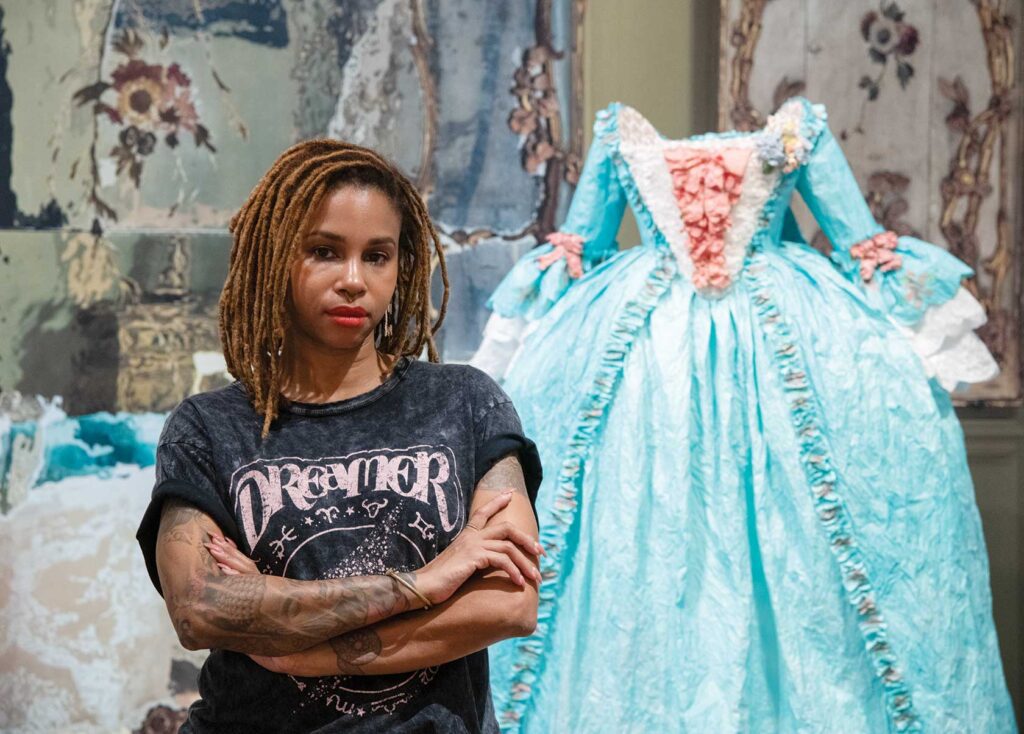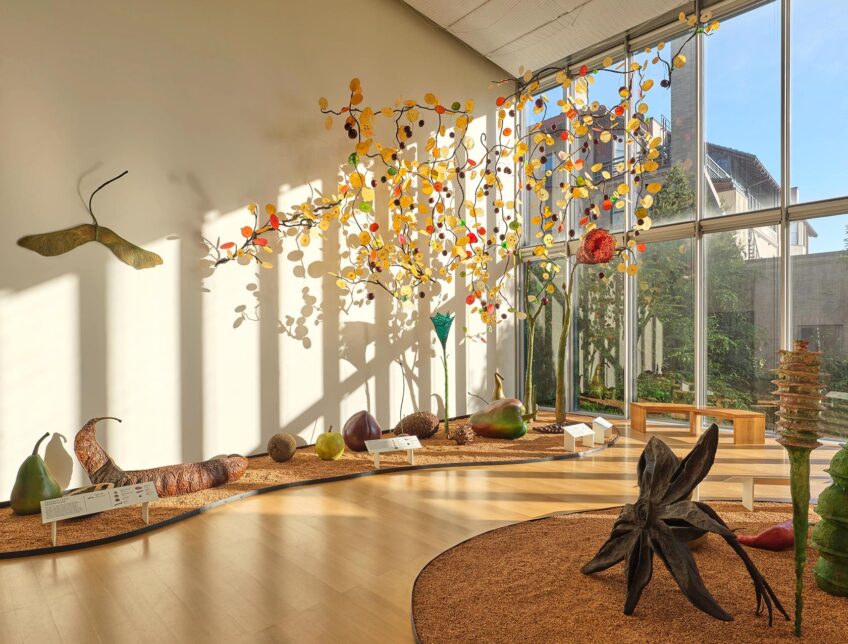Haitian artist uses fashion to probe power structures in ‘Rewriting History’ at Gardner Museum

A dress is the centerpiece of Haitian American visual artist Fabiola Jean-Louis’ exhibition “Rewriting History” at the Isabella Stewart Gardner Museum, though the term hardly seems sufficient to describe this artwork. The electric blue gown is a careful balance of elegant ruffles and pleats, featuring the wide hip structure and low neck popular in the 17th and 18th centuries. But unlike those silk constructions, this sartorial masterpiece is made entirely out of paper.

Fabiola Jean-Louis, “Marie Antoinette is Dead,” 2017. Archival pigment print © Fabiola Jean-Louis. PHOTO: ISABELLA STEWART GARDNER MUSEUM
Jean-Louis uses intricate, delicate paper garments to question narratives around Black women and Black female bodies and to probe power structures. Dresses like the one on display were typically worn by white nobility. Jean-Louis photographs Black women wearing these at-once lavish and cage-like creations. In doing so, she reminds viewers that the wealth that supported the European nobility identified with these garments often came at the expense of Black lives. Her work at the same time exalts Black women to that same aristocratic position and aesthetic.
“There’s no other item, or material in our world — and not just American society, but in our world — that shapeshifts like paper,” says Jean-Louis. “It has in one instance tremendous power to build cities, governments, societies, wealth, poverty and suffering. It has the power to buy human bodies and has the power of serving as proof of existence.”
The material holds all of that power, but it’s also incredibly fragile. That juxtaposition of strength and weakness emulates the two sides of the clothing coin. Women can use clothing to create their own identities and express themselves, but garments can also be used to physically and societally restrict them. And it’s through the oppression of others, particularly Black people, that power was won during this time period.
“It’s fragility and power next to each other,” says Jean-Louis. “And the fragility isn’t of the Black body, actually, it’s the fragility of power.”
When women would have been wearing this style of dress — during the 1600s through 1800s — power structures around the world were beginning to break down. The French Revolution, the Haitian Revolution, the American Revolution, all of these overhauls of power were happening during this period of dress. The Haitian Revolution is a particularly poignant example, because Black, enslaved individuals overthrew their colonial oppressors and founded their own government.
The dress that’s currently on display in the Gardner Museum is one of Jean-Louis’ newest creations. She’s added a new element to her process: While she’s always used acrylic paint to color the dresses, the paint on this particular garment fades over time.
“I did that on purpose, because I really wanted to talk about how if we are complacent about how identity is stripped away from us, then it eventually does disappear,” says Jean-Louis.
Facing the dress in the exhibition are portraits of women wearing Jean-Louis’ paper creations. In the photographs, a variety of garments and accessories, including a violin and background draperies, are completely made of paper. It takes months for Jean-Louis to create these items and, because of their fragility, they often won’t survive a photoshoot. Within these images, Jean-Louis has painted scenes of and incorporated items referencing violence against Black women. Though the women are dressed lavishly and represent the power that Black women are capable of holding, their history of pain and oppression is not forgotten.
The display of Jean-Louis’ work ties in to another current exhibition at the museum, “Inventing Isabella,” in which viewers can learn how Gardner used fashion and other trappings of image to carefully curate and attempt to control public perception of herself. In “Inventing Isabella” we see a woman using fashion to exert autonomy over her own identity, an opportunity that women of color rarely had at this time.

The exhibition “Fabiola Jean-Louis: Rewriting History,” showing Garden Dress II, 2017. PHOTO: Isabella Stewart Gardner Museum
“(Rewriting History) has the glamour and ‘more is more’ aesthetic of Isabella,” says Diana Greenwald, William and Lia Poorvu Curator of the Collection at the Gardner Museum. “But it is a corrective to our insidious assumptions that Black women are not inhabiting this aesthetic.”
The third prong of this exhibition collection is an exterior installation by Mexican artist Carla Fernández titled “Tradition is Not Static.” Showcased on the entrance side of the museum, Fernández’s mural highlights Indigenous artistic practices and their impact on current-day fashion.
This is just the beginning of Jean-Louis’ collaboration with the Gardner Museum. The artist-in-residence will engage in a massive takeover of the museum in 2025, presenting work in every exhibition space in the museum, which is extremely rare. The 2025 exhibition will explore how Black spirituality has inspired Black freedom.
Despite its stagnant core exhibition halls, in which, as dictated in Isabella Stewart Gardner’s will, the art has remained unchanged since her death, the museum has blossomed into one of Boston’s most progressive and dynamic museums. This large-scale collaboration with Jean-Louis, a Black artist with an immense and important career ahead of her, is an example of the museum’s finger on the pulse of contemporary art.
Jean-Louis uses clothing to vindicate Black women, putting them in aesthetic positions of power they deserve to be in, but she also uses it to expose the historic oppression that built the trappings of wealth and power. “Rewriting History” also illustrates what an important artistic tool fashion is.
“It’s really about claiming space,” says Jean-Louis. “And using fashion to vandalize narratives that don’t serve the people that they’re against.”








